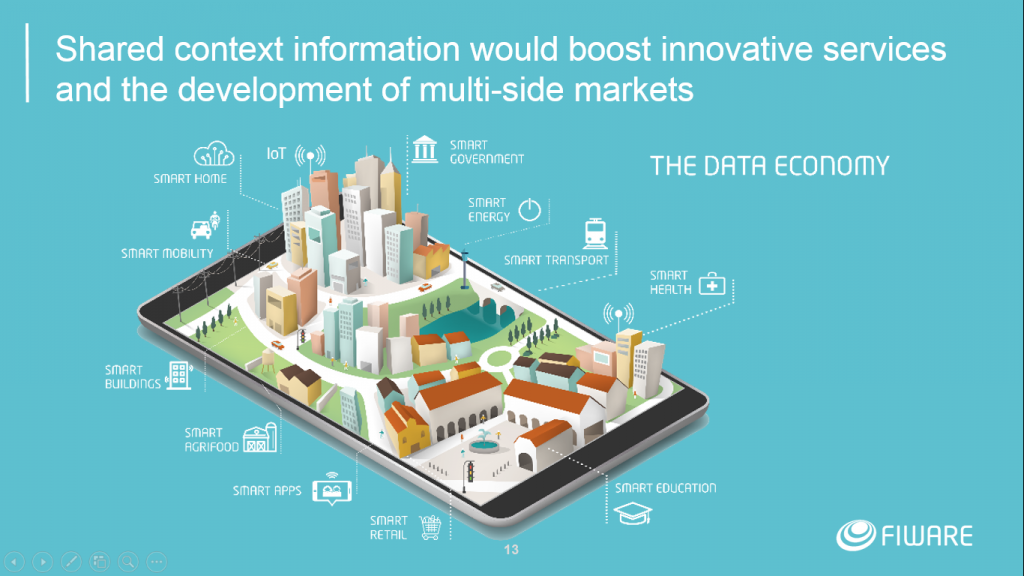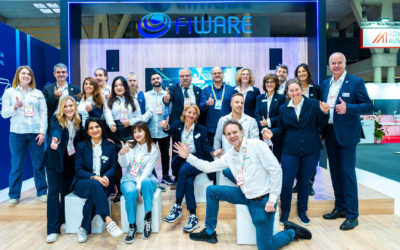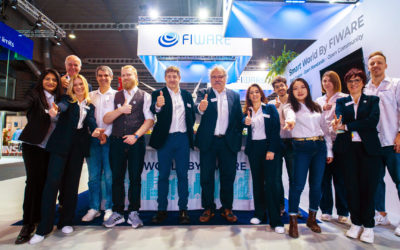ETSI, the European Telecommunications Standards Institute, has announced the creation of a new Industry Specification Group on cross-sector Context Information Management (ISG CIM) for IoT-enabled Smart Cities and also other verticals including Smart Industry and Smart Agriculture.
The group will focus its activities on developing the specifications for a common Context Information Management (CIM) API, Data Publication platforms and standard Data Models, in order to achieve and improve cross-sector interoperalibilty for smart applications, with FIWARE NGSI as starting point. This blogpost offers further information on the role of FIWARE within the works of this new group.
As CIM API, the abstract NGSI 9 and 10 interface specifications from OMA will be the starting point, with a RESTful binding for the protocol based on the FIWARE NGSIv2 API developed under the FIWARE initiative. Specifications of this binding are expected to evolve in order to bring support to Linked Data using JSON-LD for representing the semantics of context information and their interrelationships.
As the press release by ETSI states, “Data without context are meaningless. Every sensor measurement, every entry in a database, every tweet sent and every webcam video watched has its own context.” Information will not be really useful without its own context; a context that should be published and made available with the data. The ISG CIM will specify open standards for the context information management layer that accesses and updates information coming from different sources (IoT networks and information systems) thus enabling to implement a context-aware behaviour for smart applications and extending its interoperability.
“With the rapid development of technologies such as Big Data, semantic web, complex workflow or autonomous decision making, the need for interoperable context information is becoming huge”, says Lindsay Frost, convenor of ETSI ISG CIM.
Lindsay Frost explains how the newly launched group will aid to overcome this problem: “The ISG CIM will specify protocols running ‘on top’ of IoT platforms and allowing exchange of data together with its context, this includes what is described by the data, what was measured, when, where, by what, the time of validity, ownership, and others. That will dramatically extend the interoperability of applications, helping smart cities to integrate their existing services and enable new third-party services.”
These will be the topics addressed by ISG CIM in order to ensure interoperability of independent SW implementations, including Open Source implementations,
-
Definition of a standard API for Context Information Management, enabling close to real-time update and access to information coming from many different sources (not only IoT). Such an API will enable applications to perform updates on context, register context providers which can be queried to get updates on context, query information on current and historic context information and subscribe for receiving notifications on context changes.
-
Specifications to be fulfilled by Data Publication Platforms supporting open data publication, data privacy and/or authorization of access, including enablers for multi-party access contracts will be considered.
-
Cross-domain Context Information Models that will deal with the definition of the models that are common to several of the domains being targeted, together with the meta models, definition languages and processes needed for the specification, curation, publication and evolution of Context Information Models will be defined and applied.
-
Smart Cities Information Models, where the specific models for the Smart Cities domain will be defined.
- Information Models targeting other specific domains besides Smart Cities (for example but not limited to Smart Agrifood, Smart Industry) will also be considered.
The starting members of the new Industry Specification Group (ISG) are Easy Global Market, IMEC, NEC, Orange and Telefonica. ETSI has initiated this new group together with the organisation Open & Agile Smart Cities (OASC). Soon, the FIWARE Foundation will also join the ISG as new ETSI member. Beyond the initial focus of Smart Cities, the cross-sector approach will be transferable to applications developed for other vertical domains, such as Smart Agriculture and Smart Industry. With the goal of interoperate and to re-use as much existing work and knowledge as possible, the group will work closely with the ETSI SmartM2M technical committee and with oneM2M, the global standards initiative for M2M and the IoT (Internet of Things) of which ETSI is a founding member.
The ISG CIM work responds to the EU’s rolling plan on ICT standardisation which is part of its Digital Single Market strategy. The creation of this group leverages promising results of the collaboration between FIWARE and other relevant actors such as TM Forum or GSMA.
The first meeting of the ISG CIM is planned to take place at the ETSI premises in Sophia Antipolis, France, on 9-10 February 2017. Regarding FIWARE, by July 2017, a preliminary version of the CIM API is expected. The final version of its specifications will be developed by November 2017. And, by September 2017, the first version of the standard Data Models would be available, thanks to the previous work in projects like CitySDK, or the joining effort of FIWARE and a group of OASC cities in collaboration with GSMA, regarding the definition of harmonized Data Models. This partnership has produced a first batch of Data Models that are fully compatible with NGSI.
Participation in the cross-sector group is open to all ETSI members as well as organizations who are not members, subject to signing ISG Agreements. For information on how to participate please contact ISGsupport@etsi.org
The full list of members and participants in ISG CIM is available at: https://portal.etsi.org/TBSiteMap/CIM/CIMmembershiplist.aspx




